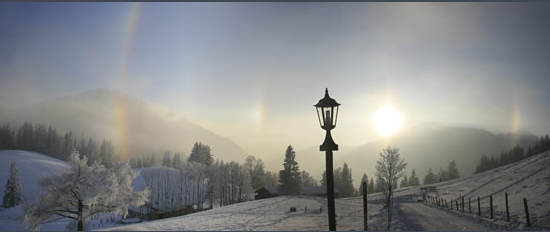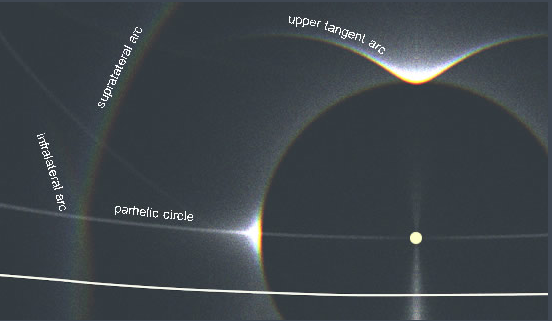Winter Halos
Winter Halos: A Spectacular Atmospheric Phenomenon
Winter is not only a season of snow-covered landscapes and chilly temperatures but also a time when the atmosphere can put on a dazzling display of optical phenomena. One such phenomenon is the formation of winter halos, which occur when ice crystals suspended in the air interact with sunlight, creating a stunning array of colorful rings and arcs around the sun. While these halos may be relatively rare, they are a sight to behold and provide a fascinating glimpse into the intricacies of atmospheric optics.
In order to fully appreciate the beauty of winter halos, it is important to understand their formation and the specific types of halos that can be observed. Winter halos are created when light from the sun enters ice crystals in the atmosphere and is refracted, or bent, as it passes through them. This refraction causes the light to separate into its component colors, similar to how a prism splits white light into a rainbow. The resulting dispersion of colors gives rise to the vibrant rings and arcs that characterize winter halos.
One of the most common types of winter halos is the 22° halo, which forms a circular ring around the sun at an approximate distance of 22 degrees. This halo is caused by the refraction of sunlight through randomly oriented hexagonal ice crystals. Another notable halo is the upper tangent arc, which appears as an arc of light just above the 22° halo. It is formed by sunlight entering horizontally oriented column-shaped ice crystals and exiting through their side faces.
In addition to these well-known halos, winter skies can also showcase more elusive phenomena. The supralateral arc, for example, is an outer halo that can be observed above the 22° halo. It is created by sunlight entering horizontally oriented column crystals and exiting through their end faces. This unique path causes the light to undergo a wide separation of colors, resulting in a distinct band of hues. On the other hand, the infralateral arc is a lower halo that curves outwards from the sun and extends beyond the supralateral arc. It is formed when sunlight enters column crystals through their end faces and exits through their side faces.
Identifying winter halos can sometimes be challenging, particularly when the ice crystal clouds are patchy and drifting. In such cases, the inner halos, 22° halo, and upper tangent arc may appear weak and diffuse compared to the stronger outer halos. However, the distinct curvature of the infralateral arc and its junction with the parhelic circle help distinguish it from other phenomena, such as the rare 46° halo.
To witness the mesmerizing spectacle of winter halos, it is essential to have the right atmospheric conditions. Typically, these halos form when the air temperature is below freezing and there are dissipating clouds containing ice crystals. The angle of the sun also plays a crucial role, with winter halos being most visible when the sun is relatively low on the horizon, typically around 8° high.
In conclusion, winter halos are a captivating atmospheric optics phenomenon that adds a touch of magic to the winter season. These intricate rings and arcs of light are created by the interaction of sunlight with ice crystals in the atmosphere. From the well-known 22° halo to the elusive supralateral and infralateral arcs, each halo offers a unique display of colors and shapes. So, next time you find yourself in a winter wonderland, keep an eye on the sky and marvel at the breathtaking beauty of winter halos.

Winter Halos - By Claudia Hinz (atmospheric optics site) at Sudelfeld in the Wendelstein area of the Bavarian Alps, Germany - 3rd January '09. The air temperature was -6C and the halo forming ice crystals were from dissipating clouds. The sun was 8° high. ©Claudia Hinz, shown with permission.


The patchy drifting ice crystal cloud somewhat hindered halo identification. In this particular image the inner halos, 22° halo and upper tangent arc are surprisingly weak and diffuse in contrast to the strong outer halo(s). usualyy we have the reverse.
The upper outer halo is a supralateral arc from horizontal column crystals. The sun's rays enter a prism side face and leave through an end face. the faces are inclines at 90° yielding the wide colour separation.
The lower halo, an infralateral arc, rises upwards and curves outwards from the sun. It projects above the parhelic circle extending beyond the supralateral arc.
To form the infralateral arc sunlight enters the end faces of column crystals and leaves via a prism side face - the reverse of a supralateral arc path.
The curving infralateral arc and the cusp shape at the junction with the parhelic circle allows the arcs to be distinguished from the more rare 46° halo which nonetheless could also be faintly present.
Note: this article has been automatically converted from the old site and may not appear as intended. You can find the original article here.
Reference Atmospheric Optics
If you use any of the definitions, information, or data presented on Atmospheric Optics, please copy the link or reference below to properly credit us as the reference source. Thank you!
-
<a href="https://atoptics.co.uk/blog/winter-halos/">Winter Halos</a>
-
"Winter Halos". Atmospheric Optics. Accessed on November 21, 2024. https://atoptics.co.uk/blog/winter-halos/.
-
"Winter Halos". Atmospheric Optics, https://atoptics.co.uk/blog/winter-halos/. Accessed 21 November, 2024
-
Winter Halos. Atmospheric Optics. Retrieved from https://atoptics.co.uk/blog/winter-halos/.